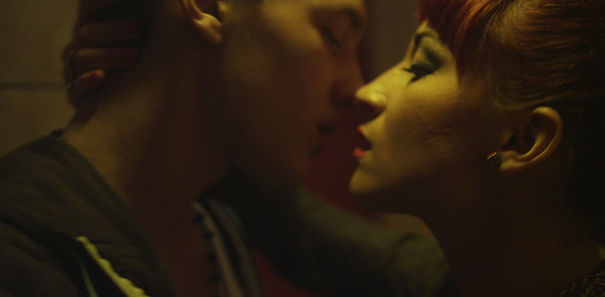Exit Fuzzy Reality. Enter Naked Death.
Ivan Velisaljević of the 2013 Talent Press Sarajevo reviews the short film MORNING PRAYERS, directed by Konstantina Kotzamani and Katarina Stanković.

MORNING PRAYERS by Konstantina Kotzamani and Katarina Stanković
MORNING PRAYERS is a short film made by the promising young filmmakers of the Sarajevo City of Film workshop, a project that connects talents from different South-Eastern European countries and shoots their films in Sarajevo, in just a couple of days. As such, its main goal is to become a show-reel for its makers, a little exercise in teamwork, through a creative and original usage of the craft. So if we take it for what it is, MORNING PRAYERS is a decent effort, an interesting little film that could be a good springboard for its young authors.
The story takes place in Sarajevo at night, as we follow two teenagers, a boy (Ismir Gagula) and a girl (Hana Pašić), trying to bond and make out, to enjoy their wonderful world of sex and drugs, but who finally end up in the bleak reality of the adulthood – characterized by death and symbolical prison bars. Of course, to some extent the film uses a worldview that we have seen many times in movies that celebrate youth or youth subcultures. What stands out in this film is how the filmmakers used focus as a device for showing altered perception, and how they played with the point of view and expectations of the audience.
For example, at the beginning of the movie we see a young boy coming in and out of focus, the streets become blurry from time to time, while the hand-held camera shakes and roams unsteadily, trying to keep the hero in the center of the frame. This blurry and hazy reality is not shown only in the boy's point-of-view shots but in the distanced, objective long and medium-long shots as well, with the background and foreground moving in and out of focus.
This playing with focus and perspectives becomes the most significant device in the film. When the boy meets the girl and asks her if she's real, we are also inclined to question her reality and feel a certain ambivalence for it, since we are not really sure from whose perspective we should see the night trip of the two characters. Soon, the hand-held camera calms down a bit, and in a long shot from the distance we see the two arriving at their final destination – the "Parrot" (Papagajka) building, a residential block of a postmodernist architectural style. Yet, at certain points, the framing separates the boy from the girl. In one shot we only see the boy climbing the stairs, and are still wondering whether the girl is real or not, while his questions add to the ambivalence, since he asks where they are, what floor is it, and so on. The two finally join in one of the apartments inside the Parrot building, and they begin their joyful erotic activities.
Unfortunately, the boy must go to the toilet, where the climactic scene of the film happens: he finds an old man in the bathtub, lying naked in the water, barely breathing. The image gives us a naturalistic impression, but it has an almost surrealistic quality at the same time, since we are still connected to the boy's perspective and his state of mind. Has this trip become really bad for him, his young eyes no longer confronted with bright colors and fuzzy objects, but with the striking images of an aged body approaching death?
After that, the style of the film changes into a more realistic depiction of everyday life and we are given certain plausible explanations. The old man was somebody whom the girl was taking care of for a while, and she brought the boy into the apartment because she thought the old man wouldn't be there, but in the mosque, at sabah-namaz, the Morning Prayer ritual. Therefore, this short film could be viewed as the two kids' search for the spiritual experience, far removed from the world of the old man who died in the bathtub while preparing to pray. So, at the start of their careers, these young filmmakers from Sarajevo City of Films used their skills not only to tell a comprehensible story, but also to convey the metaphorical meaning as well.

